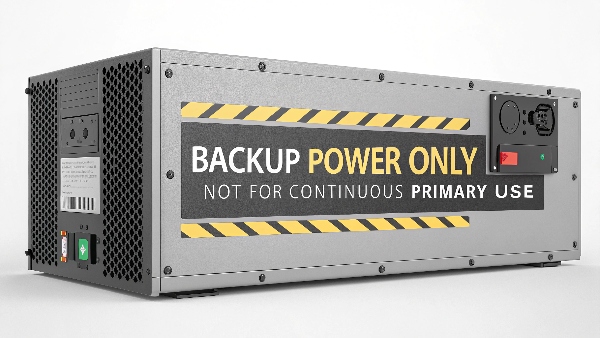A power outage strikes, halting operations and threatening your valuable equipment. This downtime is costly and stressful. A UPS instantly provides backup power, protecting your assets and ensuring continuity.
A UPS (Uninterruptible Power Supply) is your first line of defense. It instantly switches to battery power when the main supply fails, keeping critical electronics like computers and servers running. This gives you time to save work and safely shut down equipment, preventing data loss.

Transition Paragraph:Daopulse
In my ten years at Daopulse, I've helped countless clients, from hospital Procurement Managers to data center System Integrators, navigate the complexities of power protection. A common understanding is that a UPS is a backup. But I've always emphasized a key insight: a UPS can be used not only as a backup power source but also as an emergency power source. This distinction is crucial. "Backup" implies waiting for a failure, while "emergency" highlights its role in actively preserving critical functions the second they are threatened. This emergency-ready capability is what makes a UPS so vital. Let's explore this further.
Does a UPS truly protect against a power outage?
The power goes out, and your expensive server crashes hard. You thought you were protected, but are you really sure your UPS is doing its job completely?
Yes, a UPS offers fundamental protection by providing instantaneous battery power during an outage. This prevents abrupt shutdowns, data corruption, and potential hardware damage to sensitive electronics like computers and network devices.

Dive deeper Paragraph:
A UPS does more than just keep the lights on for a few minutes. Its protection is multi-layered, which is why we engineer them with such precision at Daopulse. The first and most obvious function is the near-instantaneous switch to battery power. The switchover time is just a few milliseconds, so fast that your electronic devices don't even notice the grid has failed. This is a world away from a generator, which can take many seconds or even minutes to start up. But the protection goes deeper. Many of our UPS models, particularly Line-interactive and Online Double-conversion units, also provide power conditioning. This means they actively smooth out sags, surges, and other voltage fluctuations from the grid. These minor disturbances can be just as damaging as a full outage over time. Finally, most modern UPS systems come with software that creates a communication link to your server or computer. If the outage lasts longer than a few minutes, this software can trigger an automatic, graceful shutdown, saving all open files and preventing the operating system from becoming corrupted. For a client like Mr. Li at a hospital, this ensures critical diagnostic equipment is protected and shut down safely, not just kept running.
What is the best backup solution for a power outage?
Choosing a backup system is confusing. Generators are noisy, solar is weather-dependent, and a UPS seems too small. What's the right choice for your specific business needs?
The "best" backup depends on your needs. For short-term protection of sensitive electronics and safe shutdown, a UPS is essential. For long-term outages powering larger loads, a generator is often better.

Dive deeper Paragraph:
As a solutions provider, we always tell clients that there is no single "best" backup; there's only the best solution for their specific application. The choice primarily comes down to your required runtime and the type of equipment you need to protect. A UPS1 is non-negotiable for sensitive electronics because it provides instant, clean power. A generator2 simply cannot switch on fast enough to prevent a computer from losing power. However, a generator can run for days as long as you can supply it with fuel. This makes it ideal for powering entire buildings or heavy machinery through extended blackouts. The ideal strategy for many businesses, especially those with critical infrastructure, is a combination of both.
Backup Solution Comparison
| Feature | Uninterruptible Power Supply (UPS) | Generator |
|---|---|---|
| Activation Time | Instant (milliseconds) | Seconds to minutes |
| Best For | Sensitive electronics, safe shutdown | Entire buildings, heavy loads |
| Typical Runtime | Minutes to a few hours | Hours to days (with fuel) |
| Noise & Fumes | None | Significant |
| Maintenance | Low (battery checks) | High (fuel, oil, regular testing) |
This layered approach is something we often design with our System Integrator partners. Our UPS provides the critical, instantaneous bridge of clean power, protecting servers and data, while giving the building's generator enough time to start up and take over the load for the long haul.
How long can a UPS actually last without power?
The power is out, and your UPS is beeping. The big question is, how much time do you really have before everything goes dark? The uncertainty is stressful.
UPS runtime varies from a few minutes to several hours. It depends entirely on the battery's capacity and the power consumption (in Watts) of the devices you have plugged into it.

Dive deeper Paragraph:
This is the most common question we get. The answer is always: "it depends on the load." The load is the total power drawn by all the devices plugged into the UPS's battery-backed outlets. A 2000VA UPS might power a single desktop computer and monitor for close to an hour. However, if you plug in a powerful network server and a few switches to that same UPS, your runtime could drop to just 10-15 minutes. It's a direct relationship: the more power you draw, the faster the battery drains. Another key factor is battery health. A brand-new lead-acid battery will provide its full rated runtime, but a three-year-old battery might only provide 50% of that time. This is a major reason we are shifting towards our advanced lithium battery UPS solutions, as they maintain their capacity for much longer. For clients needing longer runtimes, we offer solutions with External Battery Modules (EBMs). These are additional battery packs that can be daisy-chained to the main UPS, extending the runtime from minutes to hours. This is a service we specialize in, tailoring a UPS and EBM combination to meet a specific runtime target for a client's project.
Can a UPS be used as a primary power supply?
You need stable power for a remote kiosk or a sensitive lab instrument. Can you just use a UPS as a standalone power source, running it continuously off the battery?
No, a standard UPS is not designed to be a primary power supply. It's built for short-term backup. Using it continuously from the battery will rapidly degrade the battery and can damage the UPS.

Dive deeper Paragraph:
This question comes from a need for perfectly stable power, which is understandable. However, a UPS is fundamentally a backup device. Its internal components, especially the inverter which converts DC battery power to AC power, are designed for intermittent use during an outage. Running it 24/7 from the battery would cause it to overheat and fail prematurely. It would also destroy the battery's lifespan through constant deep-cycling. What people are often looking for is a power conditioner or an off-grid power system. The closest a UPS comes to this concept is an Online (or Double-conversion) UPS. This type of UPS does continuously power the load from its inverter, providing the highest level of power protection and conditioning. However, it still requires a connection to mains power to run its rectifier and keep the batteries charged. It cleans the incoming power, but it doesn't create it from nothing. For true off-grid or primary power applications, you would need a system specifically designed for continuous duty, often involving a much larger battery bank and a more robust inverter, like those found in solar power systems. As an OEM manufacturer, we design our UPS units to excel at their intended purpose: providing reliable emergency power.
Conclusion
A UPS is your essential first defense in a power outage. The best solution combines a UPS for instant protection with a long-term source. Runtime depends on load; use it for backup.

